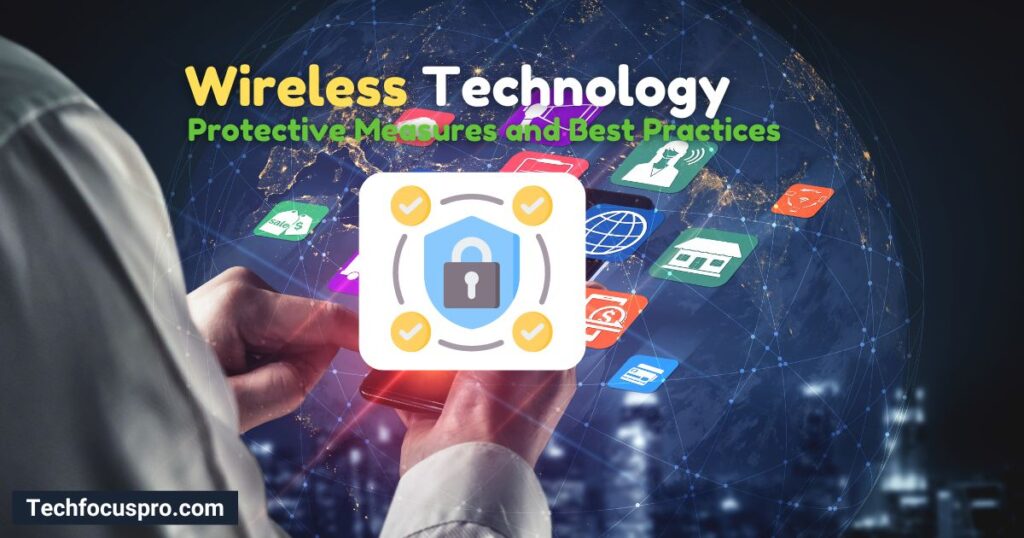How Can You Protect Your Information When Using Wireless Technology

Wireless expertise is now a communal place facet of modern life, whether we use laptops, smartphones, or smart home applications. Wireless technology is apposite, but it also places our individual info at danger.
Cybercriminals and programmers are continuously arranging better approaches to get our information, which can bring wholesale fraud, money-related misfortunes, and protection ruins. Yet, don’t stress there are simple things you can do to keep up with your information.
Data is more crucial than ever. In this guide, we will explore How Can You Protect Your Information When Using Wireless Technology? ensuring a secure and worry-free digital experience.
Let’s get started and make your digital life hassle-free and safe!
What is Wireless Technology?
Remote innovation has reformed the manner in which we associate and access data. It empowers gadgets to interface and trade information without the requirement for actual organizations or links. Wi-Fi, Bluetooth, and cell networks are normal, far-off advancements that have become key to our daily lives.
In today’s digital age, protecting your individual and subtle evidence is more critical than ever. Information security approves that your data is safe from illegitimate access and probable openings. This is vital for continuing privacy, averting identity theft, and protecting financial info.
What are the Common Risks Associated with Wireless Technology?

While wireless technology suggests many facilities, it also presents many risks. Unauthorized access, data interception, and malware attacks are nearly of the maximum common threats. Considering these risks is the first step in spread on effective security events to keep your info.
Unauthorized Access
Unauthorized access happen when cybercriminals attend in on your substructures or detention data as it is conveyed over a network. This can happen on unsafe Wi-Fi networks, where understated info like credit card numbers and individual messages can be pinched. Using encryption and protected networks can help defend your data from these intimidations.
Data Interception and Eavesdropping
Data interception and eavesdropping happen when cybercriminals tune in on your foundations or catch information as it is communicated over an organization. This can happen on risky Wi-Fi organizations, where inconspicuous data like charge card numbers and individual messages can be taken. Utilizing encryption and got organizations can assist with shielding your information from these dangers.
Malware and Viruses
Malware and viruses are pernicious programming programs intended to hurt your gadget or take your data. They can enter your framework through downloads, email connections, or contaminated sites. When inside, they can ruin records, take information, or even assume command over your gadget. Introducing antivirus programming and care away from dubious downloads are essential stages to expect malware illnesses.
Man-In-The-Middle Attacks
In a man-in-the-middle (MITM) attack, an attacker secretively blocks and transfers messages between two meetings that they are debating directly with one another. This permits the aggressor to catch, modify, or take delicate data. MITM goes after frequently happens on open Wi-Fi organizations, so utilizing a Virtual Private Network (VPN) can assist with getting your association and safeguard your information.
How Can You Protect Your Information When Using Wireless Technology? Protective Measures and Best Practices
Securing Wireless Networks

To keep your wireless networks secure, here are some important steps you can follow:
- Use Strong, Unique Passwords for Wi-Fi: Make indisputable your Wi-Fi network password is strong and excellent. Sidestep using straightforwardly guessable passwords like “12345678” or “password.”
- Enable WPA3 Encryption: WPA3 is the newest and most safe encryption standard for Wi-Fi. Safeguard your router uses WPA3 to possess your information harmless.
- Change Default SSID Settings: Your Wi-Fi network’s SSID is the name. Please modify the avoidance SSID to approximately unique to make it stiffer for hackers to goal your network.
Protecting Devices
Your devices need protection, too. Follow these tips to keep them secure:
- Regularly Update Software and Firmware:Always keep your device’s software and firmware up to date. Apprises often contain security covers that defend your expedient from new intimidations.
- Install and Maintain Antivirus Software:Antivirus software can notice and eliminate malware and bugs. Confirm it’s installed, frequently updated, and enthusiastically successively on your device.
- Use Virtual Private Networks (VPNs): A VPN encrypts your internet connection, production it much harder for hackers to disturb your data. Use a VPN, especially on community networks.
- Disable Automatic Connection to Public Wi-Fi: Turn off the automatic joining feature for public Wi-Fi networks on your device to avoid accidental connection to indiscreet networks.
Safe Usage Practices
Adopting safe usage practices can significantly enhance your security:
- Avoid Accessing Sensitive Information on Public Networks: Avoid responsibilities like online investment or any movement relating to sensitive data when using public Wi-Fi, as these networks are fewer safe.
- Educate Users on Phishing and Social Engineering Scams: Be conscious of phishing emails and social manufacturing tactics intended to trick you into giving up individual data. Always confirm the bases before ticking on doubtful links.
- Use Multi-Factor Authentication (MFA) Wherever Possible: MFA transports an additional layer of security by needful extra than one technique of verification, such as a password and a code shown to your phone.
By following these protective measures and best practices, you can significantly reduce the risks associated with wireless technology and keep your information safe. Stay informed and vigilant to enjoy a secure digital environment with Cloudspace Technologies.
Advanced Security Measures

To improve your data security, consider applying innovative security procedures. These measures offer an extra layer of safety against classy cyber threats. Here are some key approaches:
Implementing Intrusion Detection Systems (IDS)
Intrusion Detection Systems (IDS) are calculated to display network traffic for mistrustful happenings and possible threats.They can alert you to unusual behavior on your network, selection you reply quickly to stop security openings. There are two chief categories of IDS: network-based IDS (NIDS) and Host-Based IDS (HIDS). NIDS monitors the whole network, while HIDS emphasizes on separate diplomacies.
Monitoring Network Activity
Constantly monitoring your network activity is crucial for detecting security matters. By regularly checking logs and reports, you can detect any illegal access or variances. Network nursing tools can support you in tracking data flow, user performance, and application presentation, providing visions into possible security risks. Set up alerts for infrequent decorations to take instant action if needed.
Employing Secure File Storage and Sharing Solutions
Using secure file storage and sharing solutions confirms that your delicate data remains protected. Opt for amenities that offer end-to-end encryption and access control features. This way, only official users can contact or share the information. Applying secure cloud storage or encrypted external drives can also help protect your files from illegitimate admission and probable data leaks.
By including these progressive security actions into your plan, you can meaningfully toughen your fortifications and retain your information safe from progressively classy cyber threats.
Recap of Key Points
In today’s digital age, defensive data is more imperative than ever. We protected numerous key policies and best performs to improve your security:
- Securing Wireless Networks: Use durable, exclusive passwords, allow WPA3 encryption, and modification avoidance SSID settings.
- Protecting Devices:Update software repeatedly, install and preserve antivirus software, use VPNs, and incapacitate instinctive influences to public Wi-Fi.
- Safe Usage Practices: Avoid retrieving complex data on public networks, teach users about phishing, and practice multi-factor confirmation.
- Advanced Security Measures: Contrivance interruption discovery systems, monitor network movement and use safe file storing and sharing answers.
Conclusion
Caring your data is not just a practical condition; it is indispensable for safeguarding your privacy and personal data. Cyber intimidations are continually evolving, so it’s crucial to stay ahead by accepting robust security actions. By prioritizing information security, you can positively pilot the digital world, meaning that your information is well-protected.
Applying these best performs might seem intimidating at first, but attractive even small steps can knowingly recover your data security. Start with what you can succeed in and regularly include more advanced actions. Staying informed and attentive is key to preserving a secure digital environment.
FAQs
What is the importance of using strong passwords?
Using strong, exclusive passwords is critical for safeguarding your accounts and plans. A strong password makes it difficult for hackers to gain illegal access, defensive your personal information, and avoid possible breaches.
What is multi-factor authentication (MFA), and how does it enhance security?
Multi-factor authentication (MFA) requires more than one method of verification, such as a password and a code sent to your phone. This additional layer of security makes it significantly harder for unauthorized users to access your accounts.
Can cloud storage be secure?
Yes, cloud storage can be secure if you use services that offer end-to-end encryption and robust access controls. Ensure that only authorized users have access to your data, and consider encrypting sensitive files before uploading them to the cloud.
What are three ways a wireless network can be secured?
Securing a wireless network involves multiple strategies to protect against unauthorized access:
- Use Strong, Unique Passwords: Guarantee that your organization’s secret key areas of strength are not handily speculated upon. Avoid using familiar words and select a blend of letters, numbers, and unique characters.
- Enable WPA3 Encryption: WPA3 is the most recent and most secure Wi-Fi encryption standard. Empowering it gives improved assurance against unapproved access and assaults.
- Change Default SSID Settings: The default SSID (network name) can offer the kind of switch you use, making it more straightforward for programmers to target. Changing the SSID to something uniquely crafts your organization less prominent.
What is done to secure data transmitted using Wi-Fi technology?
Securing data transmitted over Wi-Fi technology involves several critical measures:
- Encryption: Utilizing encryption conventions like WPA3 guarantees that information sent over the organization is encoded, making it muddled to unapproved clients.
- VPN (Virtual Private Network): A VPN scrambles your web association, giving an extra layer of safety while communicating information over Wi-Fi.
- Regular Updates: Keeping your switch’s firmware refreshed guarantees that any security weaknesses are fixed, shielding your information from likely endeavors.
Is wireless technology secure?
Wireless technology can be secure when proper measures are taken:
- Implement Advanced Encryption: Using encryption values like WPA3 significantly improves the safety of your wireless network.
- Regularly Monitor and Update: Keeping your network strategies and software up to date and continually nursing for unusual happenings safeguards ongoing safety.
User Awareness and Practices: Educating users about protected use performs, such as recognizing phishing efforts and not sharing passwords, additional reinforces radio network security.






